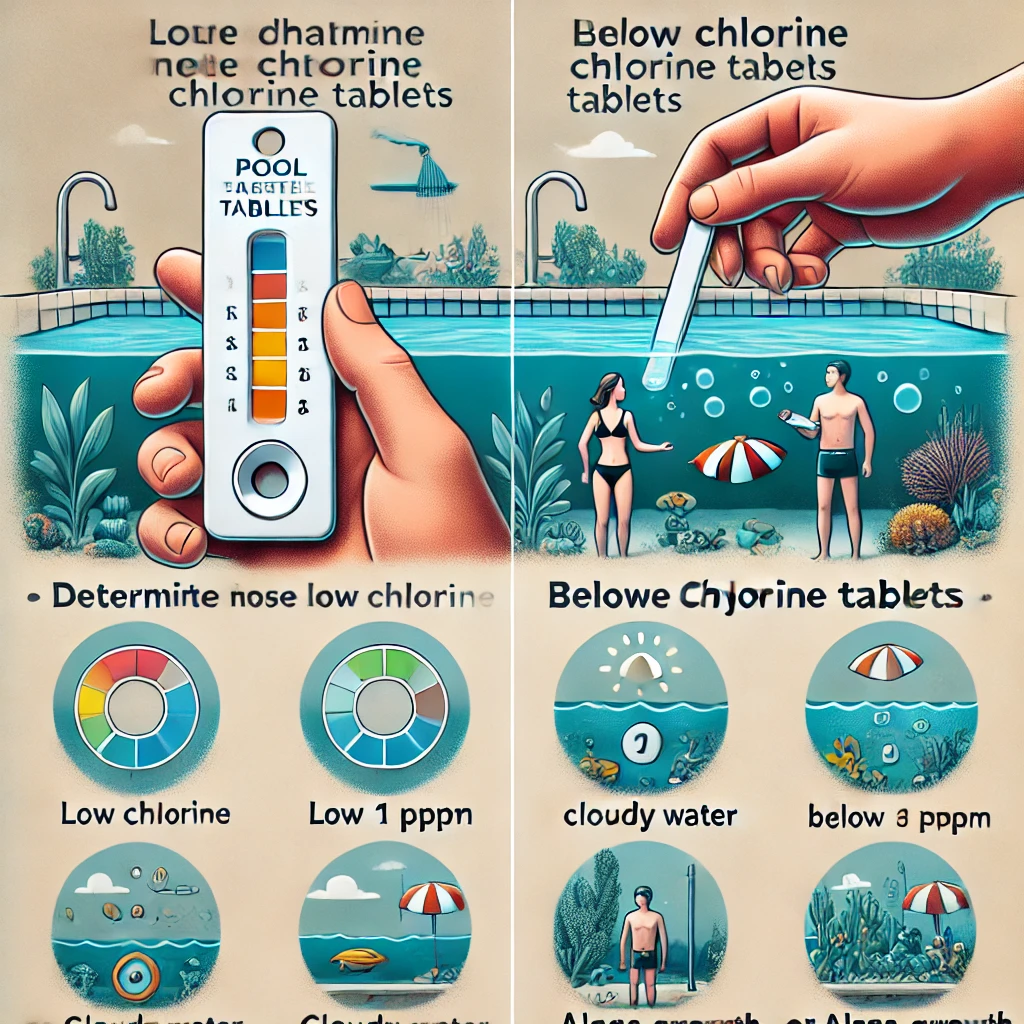Maintaining proper chlorine levels in your pool is crucial for a safe swimming environment. Chlorine tablets help keep the water clean by killing bacteria and preventing algae growth. However, it’s essential to know when to add more chlorine to ensure optimal water quality. Understanding the signs and factors that indicate your pool needs more chlorine can help you maintain a crystal-clear, healthy pool.

I. Regular Testing: The First Step in Pool Maintenance
Regular testing is the most reliable way to determine your pool’s chlorine levels. Use a pool test kit to measure the free chlorine level. Ideally, the chlorine level should be between 1 and 3 parts per million (ppm). Testing should be done at least twice a week during the swimming season. If the chlorine level drops below 1 ppm, it’s time to add more pool chlorine. Consistent testing allows you to catch low chlorine levels before they become a problem.
II. The Impact of Pool Usage on Chlorine Levels
High pool usage can rapidly deplete chlorine levels. When many people use the pool, they introduce sweat, oils, and other contaminants. These substances react with chlorine, reducing its effectiveness. After a busy pool day, it’s crucial to test the chlorine levels. If the levels are low, add more pool chlorine to restore balance. Regularly checking the chlorine levels after heavy use ensures your pool remains safe and clean.
III. Weather Conditions: How Rain and Sun Affect Chlorine
Weather significantly impacts chlorine levels. Heavy rain can dilute the pool’s chlorine, leading to lower concentrations. After a rainstorm, test the water to determine if more chlorine is needed. On sunny days, UV rays break down chlorine, reducing its levels. If your pool is exposed to direct sunlight, chlorine may dissipate faster. Using a pool cover can help reduce chlorine loss. However, if the pool remains uncovered, regular testing and adding more pool chlorine may be necessary.
IV. Visual Cues: Cloudy Water and Algae Growth
Visual signs are clear indicators that your pool needs more chlorine. Cloudy water suggests that chlorine levels are too low to keep the pool clean. Algae growth, visible as green, yellow, or black patches, also indicates insufficient chlorine. If you notice either of these issues, test the water immediately. Adding more pool chlorine can quickly restore clarity and prevent further algae growth. Regular observation of the pool’s appearance can help you catch issues early.
V. Strong Chlorine Odor: A Sign of Imbalance
A strong chlorine odor might seem like an indicator of too much chlorine, but it often signals the opposite. This smell is caused by chloramines, which form when chlorine binds with contaminants. High levels of chloramines indicate that free chlorine levels are too low. To eliminate the odor, shock the pool with a higher dose of pool chlorine. This process breaks down chloramines and restores proper chlorine levels. Regular shocking is necessary when strong odors persist.
VI. After a Pool Party: Replenishing Chlorine Levels
Pool parties introduce a lot of contaminants into the water. With more swimmers, the chlorine gets used up quickly. After a pool party, it’s essential to test the water and add more pool chlorine if needed. Even if the water appears clear, the chlorine levels may be low. Replenishing chlorine after heavy use keeps the pool water safe for the next swim. Being proactive after events helps maintain a clean swimming environment.
VII. The Role of pH Levels in Chlorine Effectiveness
pH levels directly affect chlorine’s effectiveness. The ideal pH level for pool water is between 7.2 and 7.6. If the pH is too high or too low, chlorine won’t work as effectively. Regularly test the pH along with chlorine levels. If the pH is out of range, adjust it before adding more chlorine. Maintaining balanced pH levels ensures that the added pool chlorine is fully effective. Understanding this relationship helps you keep the pool water clean and safe.
VIII. Using a Chlorine Stabilizer: Extending Chlorine’s Lifespan
Chlorine stabilizers, such as cyanuric acid, help protect chlorine from the sun’s UV rays. Using a stabilizer can extend the lifespan of pool chlorine, reducing the need for frequent additions. Test the stabilizer levels regularly to ensure they are within the recommended range (30-50 ppm). If the levels are too low, chlorine will dissipate quickly. Adding a stabilizer when needed can save time and chlorine in the long run. This proactive approach helps maintain consistent chlorine levels.
IX. Signs of Over-Chlorination: Avoiding Excessive Use
While it’s crucial to maintain chlorine levels, over-chlorination can be harmful. Signs of too much chlorine include skin irritation, red eyes, and a strong chlorine smell. If you notice these symptoms, test the water immediately. If the chlorine level is above 3 ppm, avoid adding more until it drops. In some cases, you may need to dilute the water by adding fresh water to the pool. Understanding the balance helps prevent both under- and over-chlorination.

X. Conclusion
In conclusion, maintaining the correct chlorine levels is vital for a safe swimming environment. Regular testing, observing visual cues, and considering pool usage and weather conditions are key to determining when to add more pool chlorine. By staying vigilant and proactive, you can ensure that your pool remains clean, clear, and inviting. Proper management of chlorine levels not only protects swimmers but also extends the lifespan of your pool and its equipment. Consistent care and attention to your pool’s chlorine needs will keep it in optimal condition throughout the swimming season.



